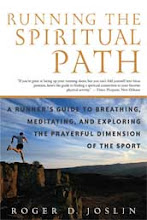
At first, you couldn't get enough of each other. The grass was greener, the sky was bluer, there was a bounce in your step. You were running on air. But as the weeks turned into months, and the months dragged into years, things changed. One day, it hits you: you've lost that spark. You're going through the motions. The thrill, as they say, is gone. So where did things go wrong? And more important, can you rekindle the flame?
I'm talking about our love for running here, folks. And your relationship with your running, just like most relationships, takes work. Here are some ideas to keep your love alive:
Respect. Running is wonderful, but if you don't respect its power, it can lash out in painful ways. Acknowledge the rigors of the sport, as well as your own limits. Translation: Don't over-reach. If the farthest you've ever run is 8 miles, don't attempt a half-marathon tomorrow. If you're accustomed to running every other day, don't go daily all at once. Show running the respect it deserves, and it will treat you right.
Spontaneity. Familiarity doesn't have to breed contempt. You know all those vacation days you've amassed? Why not use one some random weekday, and go for a long, relaxed run? Sleep in a bit and hit your favorite trail or route while everybody else is stuck at work.
Quality Time. Too many runners heap on the miles, setting themselves up to see running as nothing more than a number in the logbook. No wonder they fall out of love...what kind of relationship is that? Learn to spend time deeply breathing in the sweet spring air, watching a flock of geese winging overhead, marveling at the sheer physics of human locomotion. It'll beat miles of head-down slogging any day.
Flexibility. Not the touch-your-toes variety. We're talking about the give-and-take that is necessary for any relationship to survive. If your expectations are rigid, sooner or later something will break-most likely your spirit. Not only that, but adhering to your training schedule too obsessively may leave your priorities all out of whack. Running should bend to accommodate your life-not vice versa. If you're feeling crummy, be flexible enough to allow yourself a day without running.
Appreciation. Let's face it, our love for running is full of ups and downs. Some find themselves plagued by series of injuries along the way, while still others lose enthusiasm. Whatever it may be that keeps you from hitting the trail at times, remember to appreciate it for what it is, even if you're not out there. Running, essentially, is freedom. It's your chance to get away, to reconnect, to focus or unwind. It helps us stay healthy and fit, many times encouraging us to push the envelope, but to also remember our limitations. And sometimes, it just teaches us to be humble and know we are human. For some it is as simple as answering the age-old question of why: "Because I can."
Spread the Love. Every relationship is a two-way street, and the more you put into it, the more you'll get out. There are plenty of ways to "give something back" to the running community. From volunteering at a local race, to assisting your local high school cross-country coach, to encouraging a sedentary friend to join you for a short weekly jog. You'll feel better about yourself, and being around new runners will rejuvenate your own love for the sport.
So what are we left with? The initial thrill of the beginning runner inevitably fades. You can't stay gaga forever. The good news is that beneath the infatuation is something even better, more mature, and ultimately more rewarding-a love that will sustain you for years to come.
- Runner's World
 My wife and I have been planning a little trip for a few weeks now. We recently learned that her grandparents, who live in southern Texas, will be moving from their beautifully sunny climate back to this cold universe of the midwest in the coming months. It's been her desire for many years to visit them there, and we feel now is the best time to spend a few quality moments with them while alson offering our assistance with any packing and preparation they may have.
My wife and I have been planning a little trip for a few weeks now. We recently learned that her grandparents, who live in southern Texas, will be moving from their beautifully sunny climate back to this cold universe of the midwest in the coming months. It's been her desire for many years to visit them there, and we feel now is the best time to spend a few quality moments with them while alson offering our assistance with any packing and preparation they may have.






















